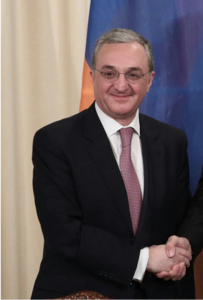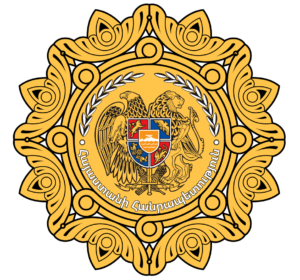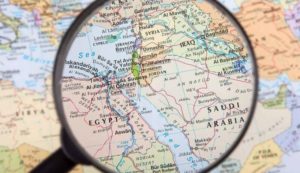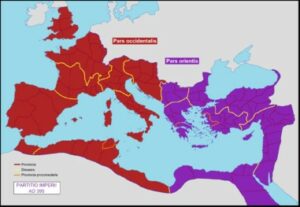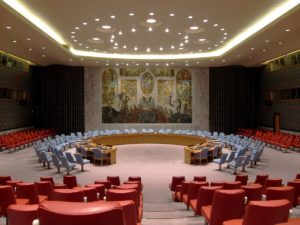Billet d’actualité par Emmanuel Goût, membre du Conseil d’orientation stratégique de Geopragma.
Not long ago, I visited the new headquarters of « Le Monde » in Paris and discussed with Isabelle Mandreau, a former correspondent in Moscow; she recently published the book “Poutine: la stratégie du désordre” en. “Putin, the strategy of disorder”), an “indictment” of Putin.
To me, Mandreau explained that she came to her conclusions “streaming together” her years as correspondent in Moscow. In French, you would say “mettre bout à bout” which in English would translate as “joining ends to ends”.
I then thought that a fun exercise would be to draw a parallel between the US and Russia – two nations which, in the best case, have never ceased their antagonisms and in the worst, that the US has never accepted any other kind of multilateralism in the world, except the one led by themselves…
Two important dates:
· 1789 the first Constitution of the United States of America (USA) was implemented; based on Common Law and on the Magna Carta (1215, UK), it was drafted in 1776 and since, amended 27 times, to become the foundation of one of the first democracies in the world of the modern era.
· 1993 first Constitution of the Russian Federation (RF), amended once (June 2020).
So 204 years after the US Constitution was signed, the Berlin Wall falls, leading to a process that will provoke the end of the USSR, start the ball rolling for the creation of a new Russian Federation and with it, for the first time, the proposition of a democratic regime.
Russia and United States: at the Eighteenth and Nineteenth Century starting block
The birth of the American constitution arises to put an end to the United Kingdom’s world supremacy. At that time, China was the biggest power in the world: the UK will make its last blow to China’s leadership during the famous “Opium wars” during the Nineteenth Century.
The US Constitution is led by a strong sense of Laic Universalism and sees in the French Revolution and the Declaration of Human Rights as an inspiration for their views of the world.
12 February 1823 Despite the basis of foreign policy with the Monroe Doctrine, the 19th century America will focus on the protection of its frontiers and mostly the handling of its internal conflicts.
What is tragically obvious are the contradictions with the principles of its Constitution e.g. the massacres of the Indian population, and its civil war.
On the other side of the world, in Russia, the autocratic Russian imperialism is broadly following the same logic: the construction of an “empire” with the main figures of the czarist regime being Catherine II, Alexander I, Alexander III, Nicolas II.
Throughout the 19th century, Russia faced conflicts from the west – the French invasion – from north by some of the Baltic’s country, and, from the south by the ottoman – the Caucasus wars – till the last war of the century on the Far East in 1904-1905, with Japan.
The sale of Alaska to USA by the Russian (1867) completed the process of reciprocal continental consolidation.
20th and 21st Century
The Roosevelt Corollary will be the real step that will boost the role of the United States in promoting their vision of worldwide universalism.
1905 With the Roosevelt Corollary – which clearly sealed the fate of UK domination on the world – and the first Russian revolution, both Nations will turn their policy from internal consolidation to different prospects of universalism, on one side the domination of USA over the world in the name of freedom, democracy and human rights, and the other side, with the Bolsheviks revolution, the communism as their version of human rights over the world, led by USSR.
The main difference is that, for more than one century, the USA already had democratic rules – albeit betrayed, while the USSR was an autocratic regime, even a dictatorship, born with gulags, for more than 70 years.
The first revolution in Russia found in the tsarist autocratic regime its political motivation, then the First World War and the economical and social situation will lead to 1917 Bolshevik Revolution.
In 1918, the Gulag # 1 is opened in Moscow. The tragic internal history of the Bolshevik regime ends in 1991, 30 years ago – only 30 years ago!
The fight between the two universalisms will easily turn into a huge advantage for the US.
Taking a step back, it is not possible to not notice that what has always been behind this US “by-now-old democracy” are excellent marketing skills forever present as a “new democracy” and fantastic orchestrations of the fights for freedom and democracy up until Biden’s recent election – Biden, who clearly outlines his policy and priorities “… trust in USA worldwide leadership”, “America is back again”. I had never noticed they had left! “America first” is a leitmotiv for all American presidents, this is understandable if one is an American citizen, less if not.
The fantastic marketing of the US explodes after the Second World War: in fact they enter the war only after the Japanese attack Pearl Harbor (quite late) but they come out of it as the savers, the winners of the war. Truth be said, the US had fifty times less deaths than the USSR, but the Marshall plan and its collateral cultural strong commitment were the basis of a common understanding, they definitely are the savers and winners: the industry of the cinema, the cultural industry, the links between the American international policy and all potential institutions and partners all supported the US ‘winner’ propaganda; all the while, the communist era and expansion was almost exclusively and rightly linked to obscurantism (at best).
The US fight for Democracy and Freedom had different multiplicities which can be understood through a worldwide (*) overview:
In South America, the trend was the promotion, installation and support of dictatorships. In the Far East, the tendency was the direct military regime which then expanded to the countries in the Middle East (at the exception of Iran where till now, US has limited itself to the backing of a putsch in the 50s). Closer to the USA, small invasions of new territories: in Europe, except for the former Yugoslavia bombing, the “war of influence” was the genesis of soft power strategy, at any level of the political, institutional, cultural and industrial scene. (**)
Recently in terms of “US communication in the last decades”, the Oscar of US cynicism was Colonel Powell’s “exhibition” to the UN of fact-backed fake news to motivate a unilateral invasion in Iraq.
USSR (Union of Soviet Socialist Republics) ended in 1991. The basic rules for the first Russian Democracy were introduced by President Yeltsin. 30 years on, after Russia is still far from a democratic regime as the west understands and intends it. Russia has had to go through a “Far East” era (with analogy to the image of Far West) in the 1990s with lawlessness at every level, before being able to reinstate a governmental authority and create the environment for serious growth in every field, especially in social and economic domains together with a new international commitment. It is also impossible to avoid mentioning the internal wars in Chechnya (also motivated by the risk of Islamism expansion), the poisoning attributed to Russian agents, the assassination of journalists or the lack of opposition. Despite those terrifying facts, the country remains a country where access to the internet is today one of the freest in the world and the various accusations of the regime have not yet been proven or confirmed (although “the west” considers it certain). Finally, it is impossible not to mention the tensions with Georgia and Ukraine (despite Crimea who confirmed in a second referendum its will to be part of Russia and is now irreversibly part of Russia), both countries asked to join NATO, last step of a contradiction with US administration commitments in the 90’s, provoking an auto-defensive reaction. On the contrary the new Russia did not export war – the last invasion of a country by the USSR was Afghanistan. Looking at the maps below, Russia faces expansion on NATO alliance perimeters, expansion of US international military basis, supported by the biggest military budget – 8 times bigger than the Russian military budget. (***)
In USA, more than 175 years of democratic rules were necessary to obtain the full civil rights for the black – but black people are still dying from racial brutality -, universal free healthcare remains a dream, new extraterritorial rules create the conditions to arrest foreigners, to condemn countries or companies according to American rules: Patriot Act, SEC, OFAC, FCPA, DOJ + CIA are acting worldwide to impose their rules. Last but not least, US is still a country where the death penalty exists and where the “slavery”, under quite limited circumstances, is still constitutional (13th amendment)…
Russia on its way to democracy “could have done better” in the last 30 years, for sure, but let’s judge with equity.
Everyone constantly compares a 232 year old democracy with another that is 30 years old, without taking into consideration the political backgrounds of the US and Russia. In the USA before the Constitution, before it became the United States of America, there was almost no kind of political regime, it had a sort of “visionary virginity”; on the other side of the world, Russia’s history was built – to say the least – under centuries of autocratic regimes.
Let there be no doubt; there is an obvious double standards “deux poids, deux mesures” in the approach and in the verdict: of recent, there is worldwide support for a man who declares a fight against corruption and its power in Russia, but the same support worldwide condemns a man to jail because he shared proofs of US responsibilities in the actions we mentioned above. (****)
Awareness of these historical differences helps to explain – but not justify -, and the understanding of historical unfolding and context helps to avoid falling into the eternal Manichean reflex which can only lead to conflict.
(*) non exhaustive listing – from Eisenhower to Nixon, “Pentagon’s papers” – Chili, Argentina, Uruguay, etc… Korea, Vietnam… Kuwait, Afghanistan, Iraq, Yemen, Libya, Syria… Granada, Haiti, Panama… Serbia, Kosovo…
(**) l’ami américain by Eric Branca
(***) see the following maps, clear enough…
(****) Navalny/Assange – Snowden


